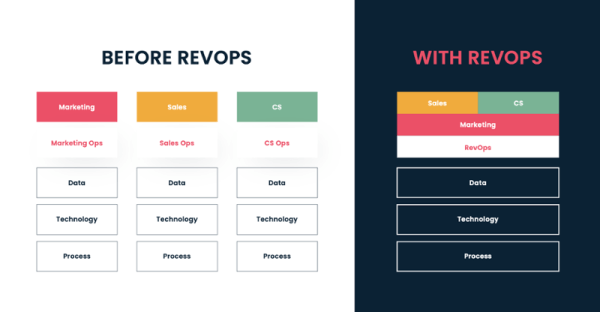






Revenue operations (RevOps) is a highly effective business function that is used to improve revenue generation, business growth, and overall organisational performance. This article will provide you with a comprehensive guide to understanding RevOps and how it can help your business succeed. We will cover the basics of RevOps, discuss its role in business growth, explore the RevOps framework, and offer insights into building a successful RevOps team.
Understanding the Basics of RevOps
Revenue Operations (RevOps) is a modern business function that has gained popularity in recent years. It focuses on developing a holistic, integrated approach to managing and optimising organisational revenue. In today's fast-paced business environment, companies need to streamline their revenue generation process, enhance data-driven decision-making, and align teams to achieve revenue growth objectives. This is where RevOps comes in.
Defining Revenue Operations (RevOps)
RevOps involves cross-functional collaboration across departments such as sales, marketing, customer success, finance, and operations. The goal is to bring together the different functions of a business that contribute to revenue generation and align them towards a common objective. This approach can help break down silos and improve communication, leading to better decision-making and more effective revenue strategies.
RevOps is not just about revenue growth, but also about improving the customer experience. By aligning teams, companies can work towards a common goal of providing the best possible experience for their customers. This can lead to increased customer loyalty, repeat business, and ultimately, revenue growth.
The Evolution of RevOps
The development of RevOps has been driven by the need for businesses to improve revenue performance in increasingly competitive markets. Traditional sales and marketing functions have become fragmented, leading to a lack of alignment and siloed data that hinders revenue growth. RevOps has evolved to address these issues and provide a unified approach to revenue management.
RevOps is a relatively new concept, but it has already gained traction in many industries. As businesses continue to face increasing competition, RevOps is becoming an essential function for driving revenue growth.
Key Components of RevOps
The components of RevOps typically include data management, performance analysis, process optimisation, technology infrastructure, and team management. Each of these components is essential to achieving revenue growth objectives and can benefit from RevOps strategies and processes.
Data management involves collecting and analysing data from different sources to gain insights into customer behaviour, sales trends, and other key metrics. Performance analysis involves tracking key performance indicators (KPIs) to measure the effectiveness of revenue strategies. Process optimization involves streamlining revenue generation processes to improve efficiency and reduce costs. Technology infrastructure involves implementing and managing the technology tools that support revenue generation. Team management involves aligning teams and providing the resources and support needed to achieve revenue growth objectives.
Overall, RevOps is a critical function for businesses looking to improve their revenue performance and stay competitive in today's market. By taking a holistic, integrated approach to revenue management, companies can break down silos, improve communication, and work towards a common goal of driving revenue growth and improving the customer experience.
The Role of RevOps in Business Growth
Aligning Sales, Marketing, and Customer Success
A crucial role of RevOps is to align teams across the sales, marketing, and customer success functions. This alignment ensures that everyone is working towards the same goals and using the same data, which translates into better revenue performance. Improved alignment means that sales teams are focusing on qualified leads generated by marketing, and marketing campaigns are optimised to achieve revenue growth objectives.
For example, a company may have a great marketing team that generates a lot of leads, but if the sales team is not properly aligned and following up on those leads, the company will not see the revenue growth it desires. RevOps can help bridge the gap between these teams, ensuring that everyone is working together towards the same revenue goals.
Additionally, customer success teams can provide valuable insights into customer behaviour and preferences, which can inform both sales and marketing strategies. By aligning all three functions, businesses can create a seamless customer experience that drives revenue growth.
Streamlining the Revenue Generation Process
Another role of RevOps is to streamline the revenue generation process by optimizing sales and marketing operations, data management, and analytics. This includes developing clear processes and workflows, identifying and removing bottlenecks, and ensuring that team members have access to the data they need to make informed decisions.
For instance, RevOps can help identify areas where the sales process can be improved, such as by automating certain tasks or providing additional training to sales reps. By streamlining the revenue generation process, businesses can improve their sales cycles, reduce costs, and increase revenue growth.
RevOps can also help businesses optimize their marketing strategies by analyzing data on customer behaviour and preferences. This data can inform decisions about which channels to use for marketing campaigns and what messaging will resonate best with target audiences.
Enhancing Data-Driven Decision Making
RevOps also plays a vital role in enhancing data-driven decision-making. By leveraging data analysis and automation, RevOps teams can provide teams with real-time insights into their performance and guide them in making data-driven decisions.
For example, RevOps can help businesses track key performance indicators (KPIs) such as conversion rates, customer acquisition costs, and customer lifetime value. By monitoring these metrics, businesses can identify areas where they need to improve and make data-driven decisions to optimize their operations.
RevOps can also help businesses automate certain tasks, such as lead scoring, relationship scoring, or data entry, which can free up valuable time for sales and marketing teams to focus on revenue-generating activities.
Ultimately, RevOps is a crucial function for businesses looking to drive revenue growth. By aligning sales, marketing, and customer success teams, streamlining the revenue generation process, and enhancing data-driven decision-making, RevOps can help businesses achieve their revenue goals and stay competitive in today's fast-paced business environment.
The RevOps Framework
The RevOps framework is a critical part of any successful business that aims to drive revenue growth. It involves the integration of various teams, including sales, marketing, and customer success, to streamline workflows, optimize processes, and maximize revenue generation. The RevOps framework comprises four key components, namely Strategy and Planning, Process Optimization, Technology and Infrastructure, and Reporting and Analytics.
Strategy and Planning
Developing a comprehensive strategy and plan is a critical part of implementing a successful RevOps function. This plan should align with business objectives and prioritize revenue growth. It should also establish clear metrics for measuring progress and define responsibilities for each team member. The strategy and plan should incorporate a data-driven approach that leverages customer insights and market trends to drive revenue growth. A successful strategy and plan should also foster collaboration and communication across teams to ensure everyone is working towards the same goal.
Process Optimization
Process optimization is about reviewing all the operational workflows that impact revenue generation and identifying areas for improvement. Once identified, changes can be made to improve efficiency while reducing redundancy and waste. Such optimization also involves proactively creating and implementing new processes or tactics to tackle specific revenue goals or market conditions. The process optimization component of the RevOps framework is critical in ensuring that the business is continually improving and adapting to changing market conditions.
Technology and Infrastructure
Technology and infrastructure are essential components of RevOps. The right technology stack can improve team collaboration, automate manual tasks, and provide insights and analytics to help teams identify areas for optimization. Whether using CRM software, marketing automation tools, or other platforms, the technology should support the broader goals of efficient revenue generation workflows and cooperation. The infrastructure component of the RevOps framework involves ensuring that the technology and tools used are scalable, secure, and reliable.
Reporting and Analytics
Reporting and analytics involve setting up dashboards and metrics tracking to assess performance, which ties into the data-driven approach. Dashboards should provide real-time insights and allow teams to make data-driven decisions with precision, speed, and accuracy. Reports also enable identifying patterns and performance variations and finding ways to adjust your approach in response. The reporting and analytics component of the RevOps framework is critical in ensuring that the business is continually monitoring and optimising its revenue generation efforts.
In conclusion, the RevOps framework is a comprehensive approach to revenue generation that involves integrating various teams, optimising processes, leveraging technology, and using data-driven insights to drive revenue growth. By implementing the RevOps framework, businesses can streamline workflows, improve collaboration, and maximise revenue generation.
Building a Successful RevOps Team
Essential Roles and Responsibilities
Building a successful RevOps team requires more than just a group of individuals who are experts in their respective fields. The team needs to have a range of different roles and responsibilities that complement each other and work towards a common goal. The team typically includes individuals who specialise in sales, marketing, customer success, data analytics, and operations. Having a mix of skills and knowledge among team members creates a framework that ensures success from the start and streamlines the processes involved.
For instance, having a sales expert on the team helps to ensure that the sales process is optimized, while a marketing expert can help to develop marketing strategies that align with the company's goals. A customer success expert can help to ensure that the customer experience is optimised, while a data analytics expert can help to provide insights that can be used to make data-driven decisions. Finally, an operations expert can help to ensure that the team is working efficiently and that processes are optimized for maximum productivity.
Skills and Qualifications for RevOps Professionals
RevOps professionals should typically have a solid sales and marketing background, as well as a good understanding of data analytics and software technology. Additionally, they should have experience in process optimization, team management, and project management. Having a can-do attitude, emphasizing continuous improvement, and being able to work collaboratively in a team environment are also essential skills for RevOps professionals.
RevOps professionals should also have excellent communication skills, as they need to be able to communicate effectively with team members from different departments and backgrounds. They should also be able to analyze data and draw insights from it, as well as be able to use software and technology to automate processes and optimize workflows.
Fostering Collaboration and Communication
Communication and collaboration are at the core of RevOps, and building a culture of openness and shared aims among departments and team members is the key to success. Teams need to be organized, with frequent checkpoints for making updates on progress, and be encouraged to share ideas and discuss solutions.
One way to foster collaboration and communication is to hold regular team meetings and brainstorming sessions. During these sessions, team members can share their ideas and insights, and work together to develop strategies that align with the company's goals. Additionally, using collaboration tools such as project management software or communication platforms can help to keep team members connected and informed.
Another way to foster collaboration is to encourage cross-functional teams. By bringing together team members from different departments, companies can break down silos and encourage collaboration between departments. This can lead to more efficient workflows, better communication, and ultimately, better results.
In Conclusion
RevOps is a crucial business function that can help companies successfully grow their revenue. It requires a comprehensive understanding of sales, marketing, customer success, data analytics, and operations, communication, collaboration, and an unrelenting focus on progress. Implementing a RevOps framework is a valuable exercise for every business looking to outpace the pack and thrive as a revenue-efficient organization.









